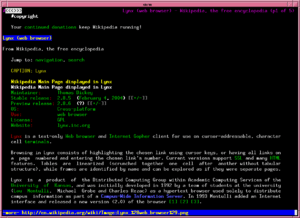Lynx (web browser) facts for kids

An older version of this article displayed in Lynx
|
|
| Original author(s) | Lou Montulli, Michael Grobe, Charles Rezac |
|---|---|
| Developer(s) | Thomas Dickey |
| Initial release | 1992 |
| Stable release | |
| Written in | ISO C |
| Operating system | Unix-like, DOS, Windows, VMS |
| Available in | English |
| Type | Text-based web browser |
| License | GNU GPLv2 |
Lynx is a special kind of web browser that only shows text. It works on simple computer screens called terminals. Imagine browsing the internet without any pictures or videos, just words!
As of 2025, Lynx is the oldest web browser that is still being updated and used. It first started way back in 1992.
Contents
The Story of Lynx
Lynx was created at the University of Kansas in 1992. A team of students and staff, including Lou Montulli, Michael Grobe, and Charles Rezac, developed it.
At first, Lynx was used to share information around the university campus. It also helped people explore something called the Gopher space, which was like an early version of the internet.
In 1993, Lou Montulli added a way for Lynx to connect to the wider internet. This made it a true web browser.
How Lynx Connects to the Internet
Lynx uses a special set of rules called communication protocols to connect to different parts of the internet. These rules help it understand how to get information from websites.
Some of the protocols Lynx supports include Gopher, HTTP (for regular websites), and HTTPS (for secure websites). It can also handle FTP (for transferring files) and NNTP (for newsgroups).
In 1995, Lynx became free for anyone to use and change. This was thanks to something called the GNU General Public License. Now, a group of volunteers led by Thomas Dickey helps keep Lynx updated.
Cool Features of Lynx

When you use Lynx, you move around by highlighting links with your keyboard's arrow keys. You can also see numbers next to links and type the number to go to that page.
Modern versions of Lynx can handle secure websites (SSL) and many parts of HTML, which is the code that builds web pages. Tables are shown using spaces, and different sections of a page (called frames) can be explored like separate pages.
Lynx can't show pictures or videos directly. But it can open other programs on your computer to view them. For example, if you click on an image link, Lynx might open an image viewer.
One big difference is that Lynx does not use JavaScript. Many websites today rely on JavaScript to work correctly. This means some parts of modern websites might not look or work right in Lynx.
Why Lynx is Fast
Because Lynx only shows text, it's super fast. This is especially helpful if you have a slow internet connection. It's also great for older computers that might struggle to load websites full of images and videos.
Keeping Your Browsing Private
Lynx doesn't load images, so it avoids "web bugs" that track your online activity. This can make browsing more private than with browsers that show graphics.
However, Lynx does support HTTP cookies, which can also track information. You can choose to allow or block cookies, or turn them off completely. Lynx also lets you clear your browsing history and cached pages for more privacy.
Making Lynx Your Own
You can change many settings in Lynx to make it work just how you like. There are lots of options you can set when you start the program. You can also change settings while you are using it.
Helpful for Everyone
Since Lynx is text-based, it's very useful for people who are visually impaired. It works well with refreshable braille displays and text-to-speech software. Lynx can describe images and other non-text content using text, which helps screen readers.
Accessing Websites Remotely
Lynx is also handy if you need to access websites from a computer that doesn't have a graphical screen. Even though it's old and text-only, you can still use it to browse many modern websites. You can even edit Wikipedia using Lynx!
For Web Designers and Robots
Because Lynx can take commands from a text file, it's used for automated tasks. This includes filling out forms, navigating web pages, and collecting information from websites. Some "web crawlers" (programs that explore the internet) use Lynx.
Web designers also use Lynx to see how search engines view their websites. This helps them make sure their sites are easy for search engines to understand. You can even find online tools that show you how a web page looks in Lynx.
Lynx can also help test how fast a website loads from different places around the world. This is useful for checking a website's performance.
Where Lynx Can Run
Lynx was first made for Unix-like computer systems. But it was soon changed to work on many other systems. These include VMS, DOS, Microsoft Windows, Classic Mac OS, and OS/2.
You can find Lynx in the software libraries of most Linux systems. It's also available for macOS through tools like Homebrew. Lynx can even be built to run on Google's Android operating system.
More to Explore
- Computer accessibility
- Links (web browser)
- Cello (web browser)
- ELinks
- w3m
- Comparison of web browsers
- Timeline of web browsers
See also
 In Spanish: Lynx (navegador) para niños
In Spanish: Lynx (navegador) para niños

